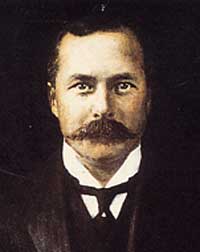1852 - 1921
Popularised litholapaxy & transvesical prostatectomy
 Peter Freyer (1851-1921) was born on 2 July 1851 in Co Galway, Ireland. Freyer went to the Erasmus Smith School in Galway, winning a scholarship to Queen's College, Galway.
Peter Freyer (1851-1921) was born on 2 July 1851 in Co Galway, Ireland. Freyer went to the Erasmus Smith School in Galway, winning a scholarship to Queen's College, Galway.
In 1872 he obtained a first class honours degree, winning the gold medal. He then studied medicine for another two years, being a resident pupil at Dr Steven's Hospital in Dublin.
He won another gold medal when conferred with his MD in 1874. He came first in the competitive examination for a commission as a medical officer in the Indian Medical Service travelling to India as acting civil surgeon at Azamgarh in 1877.
In India, Freyer became proficient in operating on bladder stone and, while based at Moradabad, attended the Nawab of Rampur, crushing his stone with a lithotrite. In gratitude for his services, the Nawab gave Freyer a lakh (100,000) of rupees, equivalent to £6,600. This caused trouble with his superiors and he subsequently returned to England to set up a private practice at 46 Harley Street where he rapidly established a reputation as a surgeon specializing in the treatment of urinary problems. In particular he became renowned for his treatment of stone. In 598 cases of transurethral lithopaxy his mortality was 1.84%, compared with a mortality of 12.5% for open lithotomy that was common at the time.
He was elected to the staff of St Peter’s Hospital for Stone in 1897.
In December 1900, he first performed a total extirpation of the prostate using a transvesical method at St Peter’s Hospital. Although he was not the first to do this, he certainly popularised this procedure. In 1912, he published his first 1000 cases in the BMJ. Remarkably, he only had a mortality of 3% in his last 200 cases
He was made a Knight Commander of the Order of Bath in 1917. In 1920, he was elected the first President of the Section of Urology of the Royal Society of Medicine (RSM).
He died on 9 September 1921.
Obituary
Read his obituary in the BMJ
Presidential Address
"Modern Progress In Urinary Surgery" - to the RSM Section of Urology, 27 May 1920.
Download a PDF of his address
← Back to Books & Articles on People in Urology